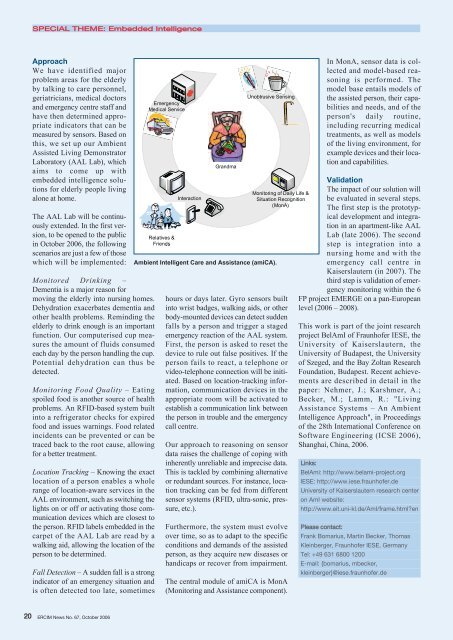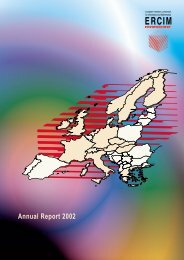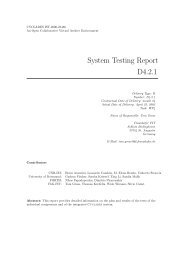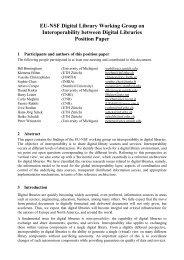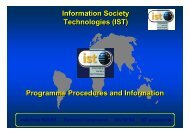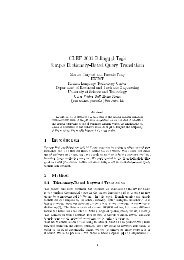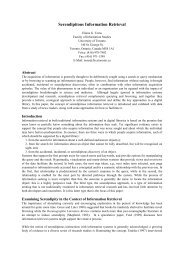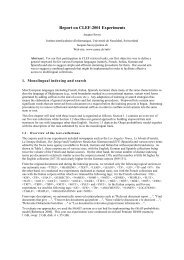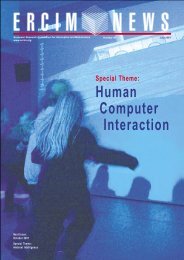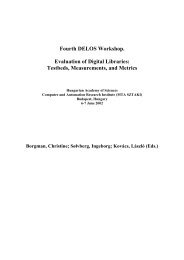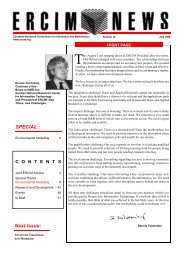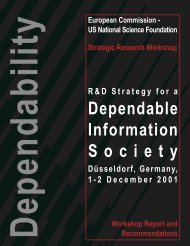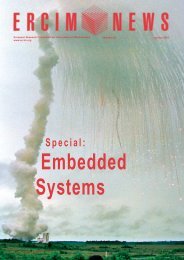Towards a Platform for Widespread Embedded Intelligence - ERCIM
Towards a Platform for Widespread Embedded Intelligence - ERCIM
Towards a Platform for Widespread Embedded Intelligence - ERCIM
You also want an ePaper? Increase the reach of your titles
YUMPU automatically turns print PDFs into web optimized ePapers that Google loves.
SPECIAL THEME: <strong>Embedded</strong> <strong>Intelligence</strong><br />
Approach<br />
We have identified major<br />
problem areas <strong>for</strong> the elderly<br />
by talking to care personnel,<br />
geriatricians, medical doctors<br />
and emergency centre staff and<br />
have then determined appropriate<br />
indicators that can be<br />
measured by sensors. Based on<br />
this, we set up our Ambient<br />
Assisted Living Demonstrator<br />
Laboratory (AAL Lab), which<br />
aims to come up with<br />
embedded intelligence solutions<br />
<strong>for</strong> elderly people living<br />
alone at home.<br />
The AAL Lab will be continuously<br />
extended. In the first version,<br />
to be opened to the public<br />
in October 2006, the following<br />
scenarios are just a few of those<br />
which will be implemented:<br />
Monitored Drinking –<br />
Dementia is a major reason <strong>for</strong><br />
moving the elderly into nursing homes.<br />
Dehydration exacerbates dementia and<br />
other health problems. Reminding the<br />
elderly to drink enough is an important<br />
function. Our computerised cup measures<br />
the amount of fluids consumed<br />
each day by the person handling the cup.<br />
Potential dehydration can thus be<br />
detected.<br />
Monitoring Food Quality – Eating<br />
spoiled food is another source of health<br />
problems. An RFID-based system built<br />
into a refrigerator checks <strong>for</strong> expired<br />
food and issues warnings. Food related<br />
incidents can be prevented or can be<br />
traced back to the root cause, allowing<br />
<strong>for</strong> a better treatment.<br />
Location Tracking – Knowing the exact<br />
location of a person enables a whole<br />
range of location-aware services in the<br />
AAL environment, such as switching the<br />
lights on or off or activating those communication<br />
devices which are closest to<br />
the person. RFID labels embedded in the<br />
carpet of the AAL Lab are read by a<br />
walking aid, allowing the location of the<br />
person to be determined.<br />
Fall Detection – A sudden fall is a strong<br />
indicator of an emergency situation and<br />
is often detected too late, sometimes<br />
20 <strong>ERCIM</strong> News No. 67, October 2006<br />
Ambient Intelligent Care and Assistance (amiCA).<br />
hours or days later. Gyro sensors built<br />
into wrist badges, walking aids, or other<br />
body-mounted devices can detect sudden<br />
falls by a person and trigger a staged<br />
emergency reaction of the AAL system.<br />
First, the person is asked to reset the<br />
device to rule out false positives. If the<br />
person fails to react, a telephone or<br />
video-telephone connection will be initiated.<br />
Based on location-tracking in<strong>for</strong>mation,<br />
communication devices in the<br />
appropriate room will be activated to<br />
establish a communication link between<br />
the person in trouble and the emergency<br />
call centre.<br />
Our approach to reasoning on sensor<br />
data raises the challenge of coping with<br />
inherently unreliable and imprecise data.<br />
This is tackled by combining alternative<br />
or redundant sources. For instance, location<br />
tracking can be fed from different<br />
sensor systems (RFID, ultra-sonic, pressure,<br />
etc.).<br />
Furthermore, the system must evolve<br />
over time, so as to adapt to the specific<br />
conditions and demands of the assisted<br />
person, as they acquire new diseases or<br />
handicaps or recover from impairment.<br />
The central module of amiCA is MonA<br />
(Monitoring and Assistance component).<br />
In MonA, sensor data is collected<br />
and model-based reasoning<br />
is per<strong>for</strong>med. The<br />
model base entails models of<br />
the assisted person, their capabilities<br />
and needs, and of the<br />
person's daily routine,<br />
including recurring medical<br />
treatments, as well as models<br />
of the living environment, <strong>for</strong><br />
example devices and their location<br />
and capabilities.<br />
Validation<br />
The impact of our solution will<br />
be evaluated in several steps.<br />
The first step is the prototypical<br />
development and integration<br />
in an apartment-like AAL<br />
Lab (late 2006). The second<br />
step is integration into a<br />
nursing home and with the<br />
emergency call centre in<br />
Kaiserslautern (in 2007). The<br />
third step is validation of emergency<br />
monitoring within the 6<br />
FP project EMERGE on a pan-European<br />
level (2006 – 2008).<br />
This work is part of the joint research<br />
project BelAmI of Fraunhofer IESE, the<br />
University of Kaiserslautern, the<br />
University of Budapest, the University<br />
of Szeged, and the Bay Zoltan Research<br />
Foundation, Budapest. Recent achievements<br />
are described in detail in the<br />
paper: Nehmer, J.; Karshmer, A.;<br />
Becker, M.; Lamm, R.: "Living<br />
Assistance Systems – An Ambient<br />
<strong>Intelligence</strong> Approach", in Proceedings<br />
of the 28th International Conference on<br />
Software Engineering (ICSE 2006),<br />
Shanghai, China, 2006.<br />
Links:<br />
BelAmi: http://www.belami-project.org<br />
IESE: http://www.iese.fraunhofer.de<br />
University of Kaiserslautern research center<br />
on AmI website:<br />
http://www.eit.uni-kl.de/AmI/frame.html?en<br />
Please contact:<br />
Frank Bomarius, Martin Becker, Thomas<br />
Kleinberger, Fraunhofer IESE, Germany<br />
Tel: +49 631 6800 1200<br />
E-mail: {bomarius, mbecker,<br />
kleinberger}@iese.fraunhofer.de


